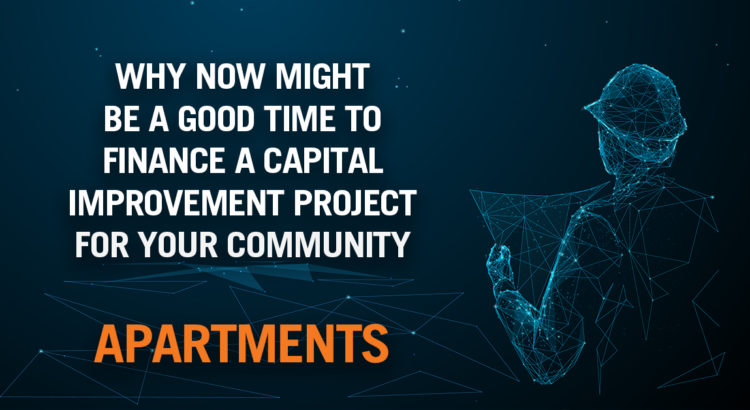
Financing Capital Improvement Projects for Apartments During COVID-19
The arrival of COVID-19 has changed many aspects of how we live, work, shop and even go to school. With extended quarantining, lengthy stay at home orders, and more people working and educating remotely, there are increased demands on all sorts of critical infrastructure ranging from internet access to plumbing to HVAC systems. As a result of increased use, the need for capital improvement upgrades (or replacements) is growing across communities; tenants are paying closer attention to their immediate surroundings, and the pressure to address these concerns is being passed on to property managers and maintenance staff.
Here at SageWater, we focus on plumbing infrastructure, and we are seeing many communities suffer from chronic leaks as their communities age and their pipes start to fail. But due to COVID-19, ownership organizations and property management companies are currently reluctant to tackle a large capital improvement projects right now due to financial concerns or logistical considerations with having workers onsite.
Unfortunately, aging infrastructure doesn’t stop aging due to a global pandemic, and while it may seem like a daunting endeavor at the moment, now is actually a great time to undertake certain capital improvement projects like pipe replacement. With interest rates at an all-time low, capital is cheap, and loans are readily available for organizations in good financial standing.
Historically, owners of apartment communities were often stuck when it came to large capital improvement projects. They either had to come up with the cash or wait until they sold the community and let the new owner deal with the improvement needs. Recently, however, apartment owners have more options available to them, including cash out refinance options specifically designed to help with capital improvements.
“With interest rates as low as they are, it is hard not to recommend exploring financing for larger capital improvement projects,” said Connor Locke, Senior Director, Real Estate Finance with Walker & Dunlop. “Interest rates are at historically low and unprecedented levels, in the mid 2-3% range. With capital being readily available and the cost of capital being so low, it’s a great time to look at borrowing. If you are an owner of an apartment building and its operating and performing fairly well, capital is readily available to most borrowers,” said Locke. “We used to see a 50/50 mix of acquisition loans and refinance loans, but due to COVID, more borrowers are going the refinance route. In addition, there are typically no restrictions on cash-out refinancing, so if you have multiple capital improvement projects that need to be completed simultaneously, that is looked at favorably by lenders; the more improvements you make to the asset, the greater the value that is being created.”
At SageWater, we are seeing more and more of our clients take the refinance option for their pipe replacement and other capital improvement needs. Frequently, they are aggregating two or three critical renovation projects and taking out a larger loan to cover them all, since rates are at historic lows. Even if your current loan has pre-payment penalties, with rates at historic lows, you can still cash out and improve your property by refinancing.
According to Locke, “Walker & Dunlop recently helped out a 264-unit garden style apartment community in the Detroit area with this exact issue. We had provided a long-term loan ~15 years ago to a community that was built in 1970. At 50 years old, the property was in need of some major cap-ex investment in the infrastructure, major system and apartment renovations. The old long-term loan still had 10+ years of term left, so there was a prepayment “penalty” as part of the overall closing costs; however, we are able to lower the interest rate by ~3% and debt service payments moving forward while providing the owner the capital they need to make any repairs as well as provide some “cash out” with no restrictions,” said Locke. “We are able to lend up to 75% loan to value and down to a 1.25x debt service coverage ratio, which should in most cases allow for plenty of excess proceeds for renovations, repairs, etc.”
If you are in need of capital improvements, Locke recommends talking to your current lender first to see what options they can provide. If you need additional resources or want to better understand what other loan products might be available, companies like Walker & Dunlop can be a great resource for exploring all your financing options.
Since some capital improvement projects, like chronic leaking pipes, simply can’t wait, knowing your options for financing is important. At SageWater, we are here to help owners and property managers navigate these difficult challenges, and can connect you with helpful resources, like lenders, to get your project off the ground. For more information, please visit us online at sagewater.com or call 888.584.9990.

Thanks to Connor Locke for contributing to this article. Connor Locke is Senior Director at Walker & Dunlop. Connor works within Walker & Dunlop’s Washington, D.C.-based Debt and Structured Finance Group. He is responsible for new loan origination and specializes in multifamily executions through Fannie Mae, Freddie Mac, Bridge, CMBS, and HUD products. In addition to conventional multifamily, Mr. Locke focuses on student and manufactured housing.


